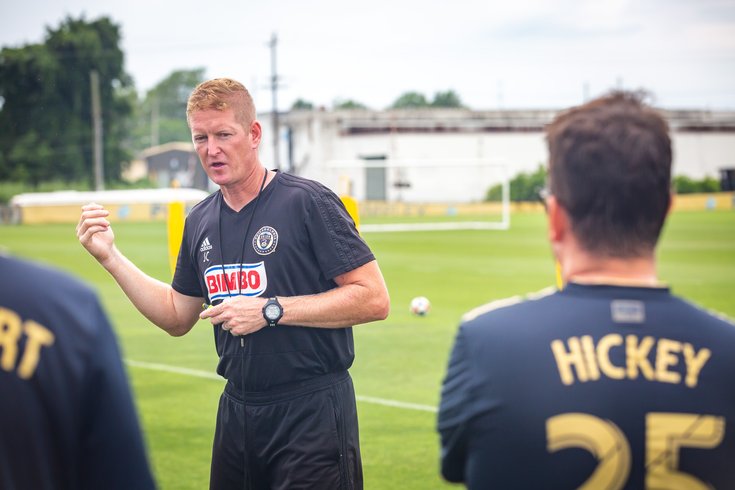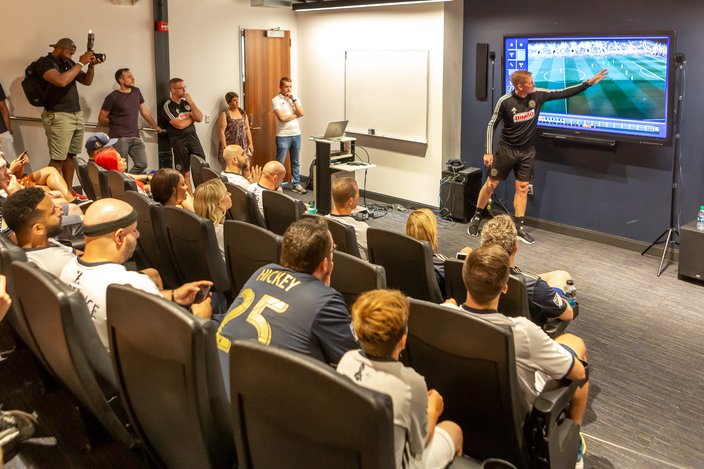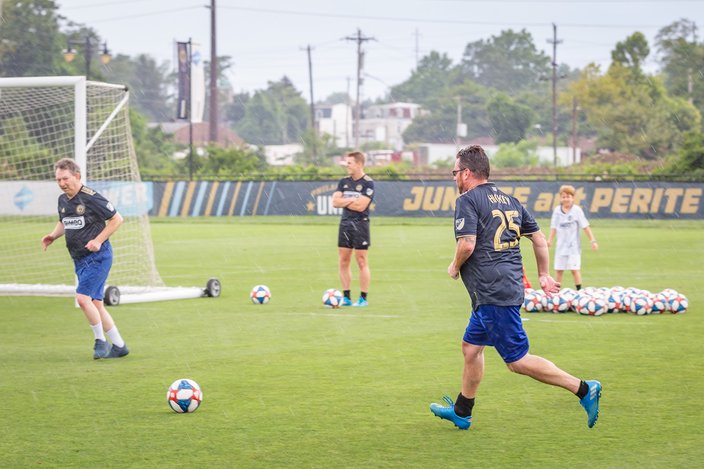
July 19, 2019
 Thom Carroll/PhillyVoice
Thom Carroll/PhillyVoice
Philadelphia Union Head Coach Jim Curtin led members of the press through a day in the life of his players during the team's Media Fantasy Camp on Thursday, July 18, 2019.
Ever dream of being a professional athlete? Yeah, not a good idea. Don’t do it.
Fine, that’s harsh, allow me to rephrase: if you’re young, talented, fit and willing to suffer for your craft, dream those dreams and work as hard as you can to achieve them.
If you’re in your forties, somewhat decent at the game, and not as fit as you thought, suffer you most certainly will.
Trust me.
I learned that lesson this week thanks to Philadelphia Union Head Coach Jim Curtin and the team’s Director of Performance Garrison Draper.
As I sit here writing on Friday morning, I am about 16 hours removed from living a day in the life of a Philadelphia Union player.
Along with two dozen others, I participated in the team’s Media Fantasy Camp at the Power Training Complex, located in the shadows of Talen Energy Stadium in Chester.
The team – which sits in first place in the MLS’s Eastern Conference as they prepare for Saturday’s match against the Chicago Fire – had just finished their daily regimen of film study, stretching (or “activation”), scrimmaging, strategizing and treatment.
Some of them moseyed through the facility as about two dozen members of the media took the team up on its invitation to do the same that afternoon.
If the players stuck around to watch what ensued, they would have all the ammunition they needed to laugh off any criticism leveled against their effort in the future.
Granted, the event wasn’t a gotcha moment. Rather, it was a unique way for the team to give writers who cover (or watch) the Union some valuable insight into what happens before the cameras start rolling on match day.
Reporters were put through the 'activation' process that Philadelphia Union players perform before taking the field on each day of training at the team's Chester facilities.
Curtin is an Oreland, Montgomery County native who chased his dreams and achieved some of them with some lofty goals remaining. He went to Bishop McDevitt High School and Villanova University, where the defender was named Big East Rookie of the Year and first-team All-Big East status his junior and senior years.
He’d go on to play for the Chicago Fire from 2001 through 2008 before returning home as a Union assistant in late 2012 and taking over the head coaching reins in 2014.
Hadn’t you known that history, you wouldn’t have picked it up in the way Curtin led reporters through a day in the life of his players. Though he's tall, there was no looking down his nose at players nowhere near as talented as his Union roster.
A friend of mine who’s known him for decades told me, “He’s one of us and a great guy.” My friend was right.
Curtin came off more as a local guy who’d kick back with a couple beers talking and laughing, rather than a taskmaster who’d chide you for firing a shot at goal from 20 yards out instead of taking a few dribbles in since no defenders were between you and glory.
“He was feeling it! Good shot,” Curtin said as my shot went over the crossbar during the scrimmage in a downpour on the pitch where the Union practice. (It was not a good shot, but I appreciated the support.)
After getting changed in the team’s practice-facility locker room, participants met in the film-study room, complete with big screens, overly comfortable chairs, and a virtual-reality system that lets players relive matches as if they were still going on.
Without revealing trade secrets, he broke down the “Philadelphia Union Pillars of Play” when the team is with or without the ball and their “defend to attack” and “transition to defense” philosophies.
Philadelphia Union Head Coach Jim Curtin breaks down game film at the team's training facility in Chester during Media Fantasy Camp on July 18, 2019.
Curtin, who recently turned 40, spoke about the challenges inherent in having a roster with players ranging from 18 to 35 years old, from 12 different countries and with various styles of communicating with one another. (“Let’s just say that there are some battles over what music’s playing in the locker room,” he joked.)
He broke down game film from recent matches – highlight things both good and bad that had happened – as he does with the real players, and noted that the team has a young training staff that’s progressive in its approach to the sport and trying new things.
Curtin spoke about how numerous hours of game film and scouting reports are broken down to about eight minutes on screen and three take-away points on which players focus both offensively and defensively for the upcoming match.
Saddling players with too much information – as much as the coaching staff would like to – has been found to be counterproductive, especially for players from the touch-screen generation.
“I know there are a lot of four for four folks here,” he said, building up to a common refrain of those who support the Union. “But it always irks me when people don’t realize there are five professional sports teams in Philly.”
Same.
From there, it was onto the gym with Draper, the team’s director of performance who walked participants through the regular pre-field “activation” process: squats, lunges, slamming of medicine balls and rolling small balls along the arch of one’s foot to help stave off plantar fasciitis, a common soccer injury.
Fully stretched – and already feeling muscles I’d forgotten existed – the two squads headed out to the fields for drills.
The drills focused on passing around a “dummy defender” and transition play (three real people vs. two real people, which turned into three vs. four if the defense won possession) before the six vs. six scrimmages commenced in a merciful downpour.
“We’ve been doing this for three and a half minutes,” Curtin said early on in the transition drill. “If you ever hear someone complain about ‘why is that person standing around out there?’ it’s a 90-minute match. Now you know.”
During the Philadelphia Union's Media Fantasy Camp, PhillyVoice's Brian Hickey learned he has to get in better shape, lest his son (background) be able to accurately claim he's a better player than his father.
Know, I most certainly did, and I wasn’t alone as the faces of those sitting on a bench near the field or in the locker room after the scrimmage matched my exhaustion.
Tell you what, though: the pain’s a small price to pay for being able to get that kind of look behind the curtain of a team playing at a high level, in a sport that you’re watching your nine-year-old son try to find his way in.
Yeah, he accompanied me to Chester on Thursday to get the same look that the media was getting, albeit being confined to the sidelines during the play, but hopping on a passing drill with a fellow reporter who needed a partner.
“It was cool, but not what I expected,” he said when I asked what he thought about the experience during which he beamed when he saw the room with all the players' cleats in them and gave their PlayStation a run through a match of FIFA. “I thought they lifted weights in the gym and that kind of stuff, not the stretches that they actually had you do."
How about the drills, and a review of our performance?
“The drills were good and the players were better than I expected," he said. "I expected less because you’re all older.”
Oh, real nice (though he echoed Curtin’s review that the quality of play picked up throughout the day.)
What about your dad, the one who offers you reviews of your matches, did he play well?
“You did pretty good, but you weren’t going right to the ball every time like you tell me to do,” he said. “And you weren’t running as much like you tell me to do, either.”
Criticisms duly noted.
Still, I’ll walk away from Media Camp with legs dragging and ego bruised (there’s some quality players covering the team, yo), but head held high since I got an attaboy from the head coach of a professional soccer team for notching my first “pro” assist.
Sure, I would’ve rather notched a goal in the match, but that’ll have to do for my professional-sports dreams coming true.
Follow Brian & PhillyVoice on Twitter: @brianphickey | @thePhillyVoice
Like us on Facebook: PhillyVoice
Add Brian's RSS feed to your feed reader
Have a news tip? Let us know.
 Thom Carroll/PhillyVoice
Thom Carroll/PhillyVoice Thom Carroll/PhillyVoice
Thom Carroll/PhillyVoice Thom Carroll/PhillyVoice
Thom Carroll/PhillyVoice